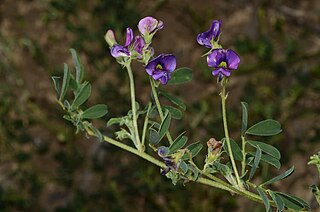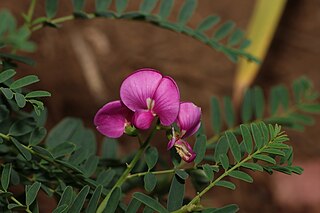
Swainsona campestris is a species of flowering plant in the family Fabaceae and is endemic to arid areas of southern Australia. It is an erect perennial herb with imparipinnate leaves with 9 to 11 linear to narrowly lance-shaped leaflets, and racemes of pink or purple flowers in racemes of 5 to 10.

Swainsona campylantha, commonly known as Gilgai Darling pea, is a species of flowering plant in the family Fabaceae and is endemic to inland areas of Australia. It is a low-growing perennial with imparipinnate leaves usually with up to 7 narrowly lance-shaped to narrowly elliptic leaflets, and racemes of 2 to 10 pink to purple flowers.
Swainsona dictyocarpa is a species of flowering plant in the family Fabaceae and is endemic to central areas of South Australia. It is a small erect perennial herb with imparipinnate leaves with 3 to 7 elliptic leaflets, and racemes of purple flowers in racemes of 2 to 6.
Swainsona disjuncta is a species of flowering plant in the family Fabaceae and is endemic to widely separated areas of central Australia. It is a prostrate perennial herb with imparipinnate leaves with 3 to 9 egg-shaped leaflets, and racemes of purple, pink or red flowers in racemes of 3 to 15.

Swainsona elegans is a species of flowering plant in the family Fabaceae and is endemic to Western Australia. It is a prostrate or ascending annual with imparipinnate leaves, usually with 7 to 15 egg-shaped or elliptic leaflets, and racemes of up to 15 blue or reddish-purple flowers.
Swainsona elegantoides is a species of flowering plant in the family Fabaceae and is endemic to north-western Western Australia. It is an erect, probably annual plant with imparipinnate leaves, with about 11 narrowly egg-shaped leaflets, and racemes of 15 to 25 purple flowers.
Swainsona eremaea is a species of flowering plant in the family Fabaceae and is endemic to South Australia. It is a low-growing, spreading, probably perennial plant with imparipinnate leaves with 5 to 11 linear, oblong to broadly wedge-shaped leaflets, and racemes of bright red to brown or yellow flowers in racemes of 5 to 20.
Swainsona extrajacens is a species of flowering plant in the family Fabaceae and is endemic to central Australia. It is an erect, annual plant with imparipinnate leaves with 9 to 21 linear, egg-shaped leaflets, and racemes of purple flowers in racemes of 5 to 10.
Swainsona fuscoviridis is a species of flowering plant in the family Fabaceae and is endemic to South Australia. It is a perennial plant with many stems and imparipinnate leaves with mostly 7 or 9 ellipitic, linear or egg-shaped or lance-shaped leaflets, and racemes of 12 to 20 purple flowers.
Swainsona gracilis is a species of flowering plant in the family Fabaceae and is endemic to the south-west of Western Australia. It is a prostrate or ascending perennial herb with imparipinnate leaves with up to 15 wedge-shaped or narrowly oblong leaflets, and racemes of up to 4 purple or blue flowers.
Swainsona halophila is a species of flowering plant in the family Fabaceae and is endemic to inland areas of Western Australia. It is usually a prostrate annual herb with imparipinnate leaves with 9 to 13 egg-shaped to broadly wedge-shaped leaflets, and racemes of 2 to 9 purple flowers.
Swainsona incei is a species of flowering plant in the family Fabaceae and is endemic to inland Western Australia. It is an erect or ascending annual, sometimes perennial herb with imparipinnate leaves with 5 to 9 lance-shaped to elliptic leaflets, and racemes of 2 to 30 purple flowers.
Swainsona kingii is a species of flowering plant in the family Fabaceae and is native to Western Australia and South Australia. It is a prostrate or ascending annual or perennial herb, with imparipinnate leaves with usually 5 egg-shaped leaflets with the narrower end towards the base, and racemes of 1 to 3 pink to purple flowers.

Swainsona laciniata is a species of flowering plant in the family Fabaceae and is endemic to north-western Australia. It is a prostrate or ascending perennial herb with imparipinnate leaves with 7 to 13 broadly elliptic to broadly egg-shaped leaflets, and racemes of 3 to 8 purple flowers.
Swainsona microcalyx, commonly known as wild violet, is a species of flowering plant in the family Fabaceae and is endemic to southern mainland Australia. It is a prostrate or low-growing perennial herb, with imparipinnate leaves with 5 to 9 broadly egg-shaped to wedge-shaped leaflets and racemes of 5 to 15 purple flowers.

Swainsona oligophylla is a species of flowering plant in the family Fabaceae and is endemic to central Australia. It is usually a prostrate perennial plant with imparipinnate leaves with 5 to 7 egg-shaped leaflets, the narrower end towards the base, and racemes of 3 to 7 purple flowers.
Swainsona pedunculata is a species of flowering plant in the family Fabaceae and is endemic to inland areas of Western Australia. It is a small, ascending annual herb with imparipinnate leaves with 3 to 7 narrowly elliptic or lance-shaped leaflets, and racemes of 2 to 3 purple flowers.

Swainsona pterostylis is a species of flowering plant in the family Fabaceae and is endemic to northern parts of Western Australia. It is a low-growing or prostrate perennial herb, with imparipinnate leaves with mostly 11 to 19 broadly elliptic leaflets, and racemes of 5 to more than 30 purple or violet flowers.
Swainsona pyrophila, commonly known as yellow Swainson-pea or yellow Darling pea, is a species of flowering plant in the family Fabaceae and is endemic to southern continental Australia. It is an erect or spreading annual or short-lived perennial plant with imparipinnate leaves with 15 to 19, mostly egg-shaped leaflets with the narrower end towards the base, and racemes of 15 to about 20 yellow flowers.

Swainsona queenslandica, commonly known as smooth Darling pea, is a species of flowering plant in the family Fabaceae and is endemic to eastern Australia. It is a perennial herb with imparipinnate leaves with 19 to 25 egg-shaped leaflets with the narrower end toward the base, and racemes of about 20 white, pinkish to orange red or dark red flowers.






